
Looking back at Magic’s extensive history, seeing how certain colors in the color pie evolved from their earliest card designs in Alpha to present day sets is very interesting. Some aspects, like blue’s affinity for countermagic or green’s affinity for efficient creatures, have remained the same.
Others, like black’s relationship with mana acceleration, have undergone a surprising amount of change in terms of how many cards they receive with the ability to generate extra black mana and how comparatively restrictive they are versus a card like Dark Ritual, one of the first and strongest go-tos for mana acceleration during Magic’s early years.
This can make finding suitable black mana ramp cards for a modern Commander deck tricky without resorting to mana rocks or nonbasic lands, as black’s earliest mana accelerators and its most potent modern designs tend to only be suited for specific types of decks.
How Does Black Mana Ramp Work in MTG?
Black’s earliest mana ramp cards were mana accelerators, cards that gave you a one-time mana boost either unconditionally or in exchange for doing something like sacrificing a creature. Occasionally these mana accelerators were tied to a specific in-game condition, like the number of creatures in your graveyard, a design trend that became more prevalent with time.
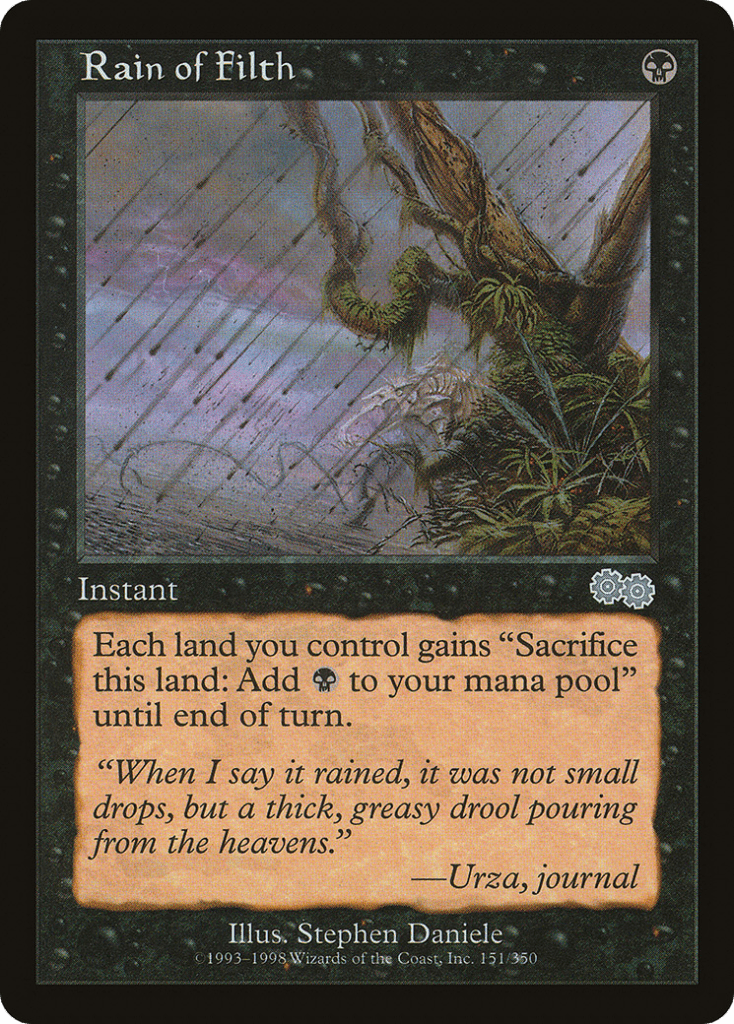
This might sound familiar if you’ve looked at blue’s selection of conditional mana ramp cards, but instead of being tied in with artifacts, instants, or sorceries, black’s conditional mana ramp and acceleration options tend to rely on the number of Swamps you control and creatures dying or existing in your graveyard.
While this does tie in with areas of the color pie black excels in, its ramp spells almost always carry a higher mana cost than any other color, making them ill suited for the early game when they are most needed.
Its best acceleration spells, while inexpensive to cast, also tend to have less impact than red or blue counterparts in most decks, effectively making black the worst color for mana ramp spells with generic Commander appeal. Fortunately, black’s section of the color pie does have some stellar nonbasic lands to help cover for that, but that’s a conversation for another article.
Between this and the fact that black’s best mana ramp spells only tend to thrive in specific niches of the Commander format, such as cEDH, mono and two color black decks, combo decks, and/or builds with reliable access to Urborg, Tomb of Yawgmoth, there’s really no way to rank these cards.
Instead, I’ll simply discuss my picks individually, and group those that will tend to go in the same decks close together when possible.
Black Market, Pawn of Ulamog, Pitiless Plunderer, Revel in Riches
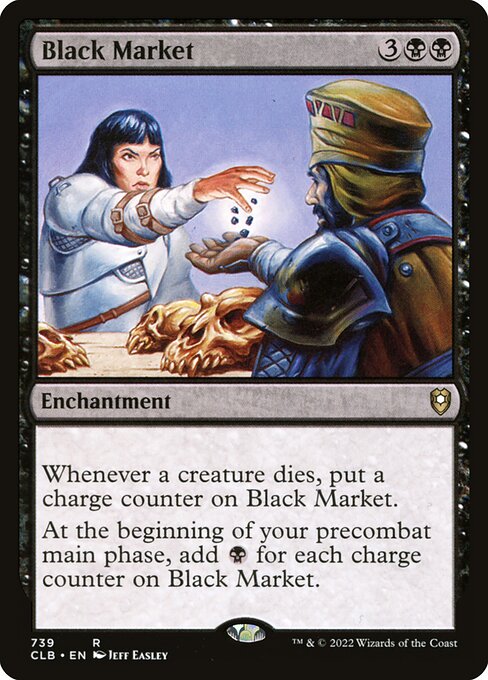
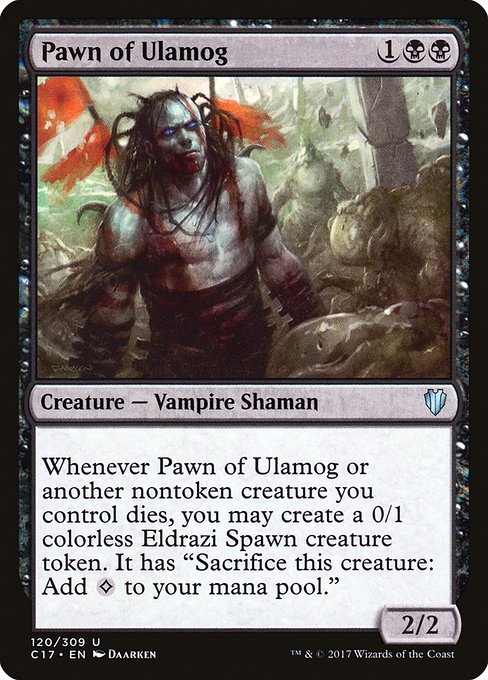
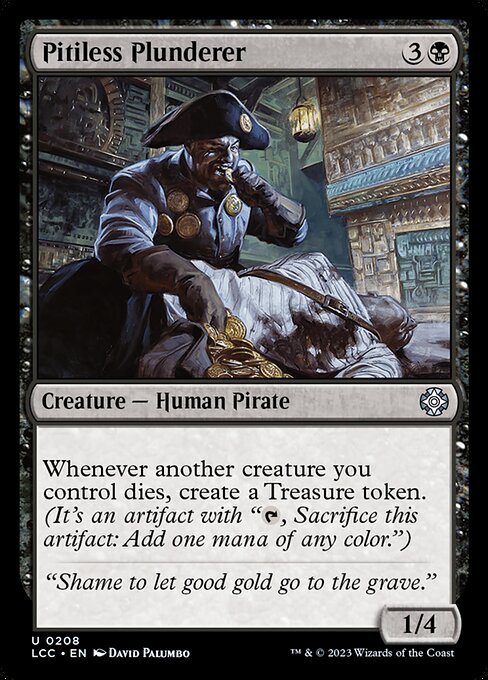

Death is often a means to an end in black, and this philosophy is all over its best mana acceleration spells. Generally, I’ve found that this concept works at its best when you don’t have to force anything on your end during a Commander game, allowing you to pick up incidental value by simply playing and letting the board state progress.
I clearly wasn’t alone in this line of thinking, because Black Market and Pawn of Ulamog saw an absolute ton of play during Commander’s early years, and the former was actually a chase card for a while since its only printing was in Mercadian Masques prior to the release of Commander 2015.
Looking back now, 5 mana is an awful lot to ask of an enchantment that doesn’t do anything when it enters the battlefield, but if allowed to sit on the battlefield after a board wipe or a couple turns of play from an Aristocrats strategy (decks that derive value from sacrificing creatures), Black Market can quickly generate game-winning amounts of black mana.
Pawn of Ulamog works in the same strategies as Black Market, though a bit more slowly since it only triggers when your own creatures die. More often that not, it was played as a hedge against board wipes in my playgroups.
Getting a bunch of 0/1 creatures is a great way to shield your life total from many threats with haste after a Day of Judgment, and then you can sacrifice those that make it to your turn to rebuild your board position with minimal fuss, and possibly even a Blood Artist trigger or three.
It also goes without saying that Black Market pairs ridiculously well with Pawn of Ulamog, and the pair have won many a Commander game over the years.
These types of mana accelerators fell out of favor after a while, and then came roaring back with the printing of Revel in Riches and Pitiless Plunderer in Ixalan block. With both in play, you’re able to net a Treasure token for each other creature that dies, and if you’ve managed to assemble 10 by the start of your next turn, you can win the game through Revel’s other effect.
With more and more Treasure support seeing print, Revel in Riches definitely sees the most widespread play out of these 4 cards today (primarily due to its alternate win condition), but all are potentially great options for decks that kill a lot of opposing creatures, sacrifice their own, or do a healthy mix of both.
Sacrifice and Culling the Weak
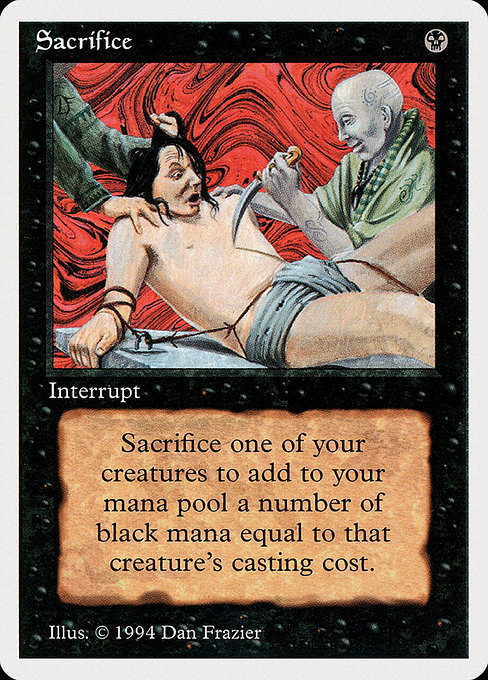
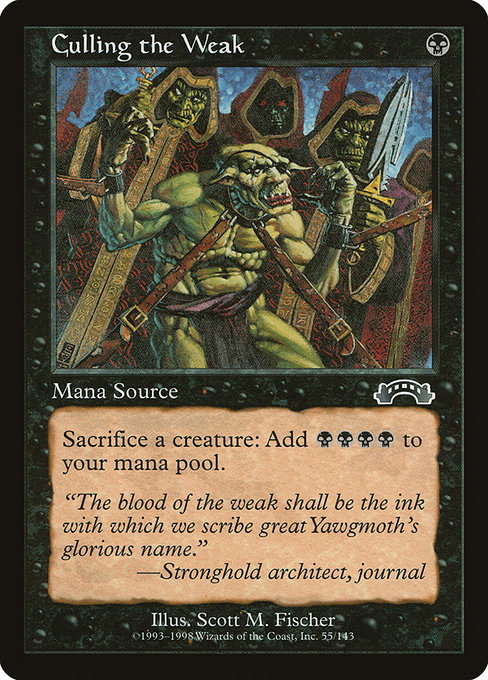
Sacrifice reminds me a lot of Energy Tap in blue, except you have to give up the creature you’re using for mana acceleration. In exchange for this higher price, you receive colored mana instead of colorless, which arguably makes Sacrifice much more helpful for powering out huge spells and powerful threats.
As with Energy Tap, the best way to get as much bang for your buck with an effect like this is to play creatures that have extremely high mana costs that become manageable to cast via cost reduction. Affinity is the most common means to this end, but reanimator cards will also get the job done quite nicely, often netting you additional value along the way.
Both have actually gotten a lot of support from Illuminor Szeras and the Warhammer 40,000 Necron Dynasties Commander preconstructed deck, giving you access to Sacrifice‘s powerful mana generation straight from the Command Zone, though you’ll have to wait a turn to use it. If that isn’t an issue though, extra redundancy is also available to your 99 via Soldevi Adnate.
Ruthless Technomancer also serves as a good inclusion in a deck looking to harness these effects, as it will actually convert your sacrificed creature’s power into Treasure tokens that you can save for a later turn, or simply cash in for an instant speed reanimation effect.
For those who don’t play a lot of big creatures in order to optimize efficiency, as is common with cEDH decks, Culling the Weak is going to be better suited to your needs. Sacrificing a cheap creature for a net of 3 extra mana on turn 1 or 2 will often open up some very explosive early plays, especially in decks revolving around K’rrik, Son of Yawgmoth.
K’rrik, Son of Yawgmoth
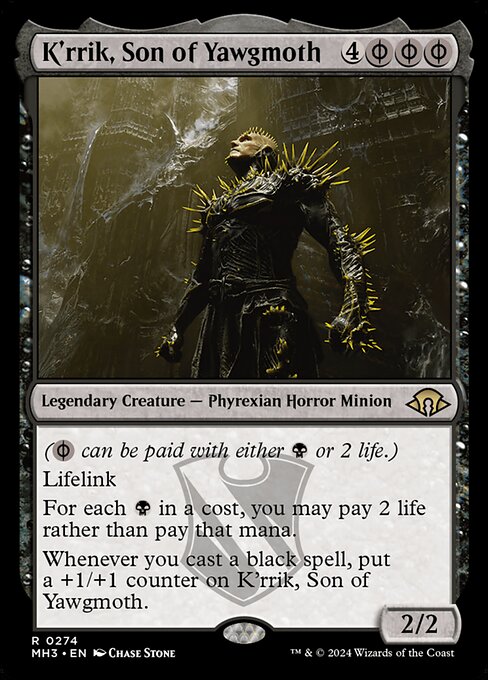
Phyrexian mana is an absurdly strong mechanic whose ripples have been felt across all Magic formats since its introduction in New Phyrexia over a decade ago. The ability to substitute life for colored mana fundamentally breaks how MTG’s mana system works by meshing a cost reduction mechanic with one that removes the relevance of the color pie.
Fast forward several years to Commander 2019, and suddenly we have a creature that can not only let you abuse this mechanic all the time, but is also available in your Command Zone if you so choose for 4 mana and 6 life.
In a format where you start with twice the normal amount of life. -sigh-
Commander’s emphasis on color identity in deckbuilding has successfully kept K’rrik, Son of Yawgmoth from being a huge problem in the format as a whole, but it’s still a powerhouse that should be removed or countered on sight against decks with a large or exclusive emphasis on black, as 4 mana can easily become as much as 16, more if life gain enters the equation.
Jet Medallion, Bolas’s Citadel, draw spells, tutors, and black cards that lack colorless requirements in their mana costs tend to work best with K’rrik, as they help you stretch your mana and card access into ridiculously explosive turns that can win you the game on the spot if your opponents don’t have access to any interaction.
If you’re looking for an entry point into cEDH and this sounds like your type of fun, have a look at this K’rrik primer on Moxfield. It outlines several different lines of play you can use to win the game, and it doesn’t require the dual lands needed to optimize the 3-4 color partner decks of the format, making it a comparably affordable list that will compete well in any pod.
Carnival of Souls
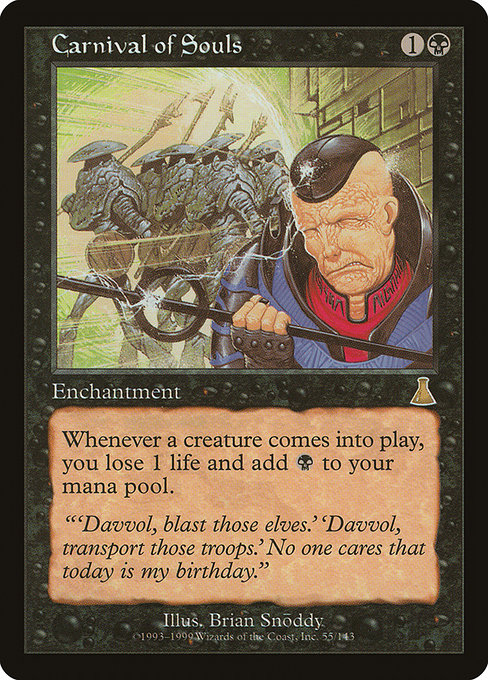
Carnival of Souls isn’t for every deck. I’ll even go so far as to say it isn’t for a lot of decks, particularly since many players looking to exercise its potential see this card as more of a mediocre combo piece than mana acceleration.
If you play a lot of life gain, low mana value creatures, and/or instant speed spells, however, this card is capable of doing a lot of work.
First, Carnival of Souls triggers whenever any creature enters the battlefield, including those played by your opponents. While this can be a little dangerous (especially against Phelddagrif decks), you can harness this effect to enable some extra mana for cards like Vampiric Tutor, Entomb, Infernal Grasp, or Village Rites while still tapping all your lands on your turn.
Second, Carnival works with any creature, including tokens, which can allow you to snowball into a lot of mana very quickly with commanders like Ghave, Guru of Spores or Teysa Karlov. If you’re feeling extra daring, you can also double up your triggers with Panharmonicon to perform a decent impression of K’rrik, Son of Yawgmoth.
Finally, you can mitigate the damage you take as it comes via creatures like Soul’s Attendant or Essence Warden, or gain a bunch of life through cards like Exsanguinate and Debt to the Deathless to offset early losses.
Granted, this path and the ones involving tokens lean a lot more in the combo direction than the mana acceleration direction, but it’s definitely worth noting Carnival of Souls‘ capability of being useful outside unreliable 3-4 card loops in these strategies, as it gets a bad rap I’m not convinced it fully deserves when reading about its capabilities elsewhere.
Blood Pet

Whether played as a slow Lotus Petal or a combo piece, Blood Pet has a home in many black Commander decks that are specifically tuned to get the most out of it.
in cEDH, Blood Pet is often found in K’rrik, Son of Yawgmoth builds as a way to net an extra mana for 2 life, but also sees a lot of play in Inalla, Archmage Ritualist and Ad Nauseam lines to rush out these expensive spells or aid in comboing off with other cards to win the game.
Weirdly, decks that focus on creating infinite loops specifically with Blood Pet are often less powerful than these cEDH strategies due to their reliance on cards like Mortuary or Enduring Renewal, which aren’t especially amazing cards on their own. Don’t underestimate these decks though – infinite combos, even when inefficient, can and will end games when unchecked.
That said, 3-4 card combos just aren’t that reliable or powerful, even with access to all the best tutors in MTG. Since cEDH tends to be the environment that finds homes for every form of efficient mana acceleration imaginable, Blood Pet is just going to be more valuable in decks tuned for that part of the Commander format than elsewhere.
Cabal Ritual and Dark Ritual
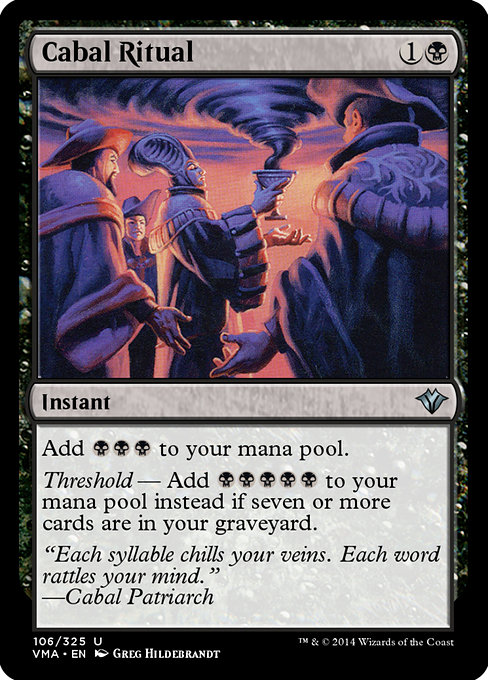

Speaking of efficient mana acceleration, you don’t get much better than the rates offered by Cabal Ritual and Dark Ritual. Dark Ritual‘s ability to turn 1 black mana into 3 at instant speed has remained unmatched since Alpha, powering out cards with incredibly potent effects like Necropotence, Doomsday, and Ad Nauseam 2 turns sooner than opponents expect to deal with them.
Cabal Ritual takes a little more work to maximize, as without Threshold, you’re only turning 2 mana into 3 black mana. Once 7 cards are in your graveyard, however, 2 mana becomes 5 black mana.
In a format where you can play mana accelerators like Lotus Petal, Jeweled Lotus, Dark Ritual, Blood Pet, a host of tutors, and cards to load up your graveyard like Entomb, it can become laughably easy to overcome that barrier throughout the course of normal gameplay or while you’re comboing off.
As with many of the combo-oriented cards discussed up to this point, these ritual effects truly shine in decks that are designed to win as quickly and efficiently as possible, meaning they’re best suited to cEDH’s competitive Commander environment.
That’s not to say these cards are bad in other Commander decks, but rushing out a turn 8 play on turn 5 or 6 just doesn’t have the same level of impact on gameplay as rushing out a turn 3 or 4 play on turn 1 unless it’s winning you the game right then and there.
Nirkana Revenant
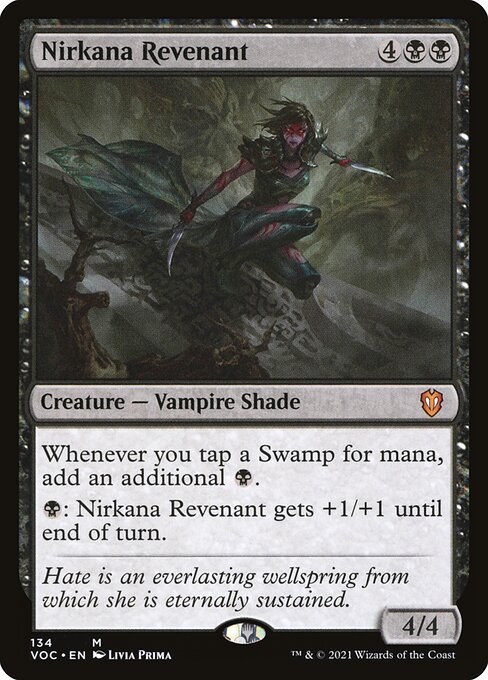
Believe it or not, Nirkana Revenant was an early staple of black Commander decks. A one-sided mana doubler that existed before the likes of Caged Sun or Crypt Ghast, Nirkana Revenant fueled many a powerful X spell while also being able to put opponents down with the aid of a Whispersilk Cloak or Akroma’s Memorial.
The subsequent printing of cards like Exsanguinate and Rogue’s Passage helped keep this once popular finisher in a lot of decks for a few years, but as the format has sped up, Nirkana Revenant has fallen out of favor with all but the most dedicated big mana decks.
6 mana is a lot to ask for a mana doubler in the modern day, and while the ability to turn that mana into power is nice, the lack of evasion really hurts this card’s ability to serve as a reliable finisher, even with an Urborg, Tomb of Yawgmoth in play.
It is still a brutal setup play for Torment of Hailfire and its ilk, however, so if you’re able to protect it, Nirkana Revenant can still be the workhorse it commonly was in years past.
Magus of the Coffers
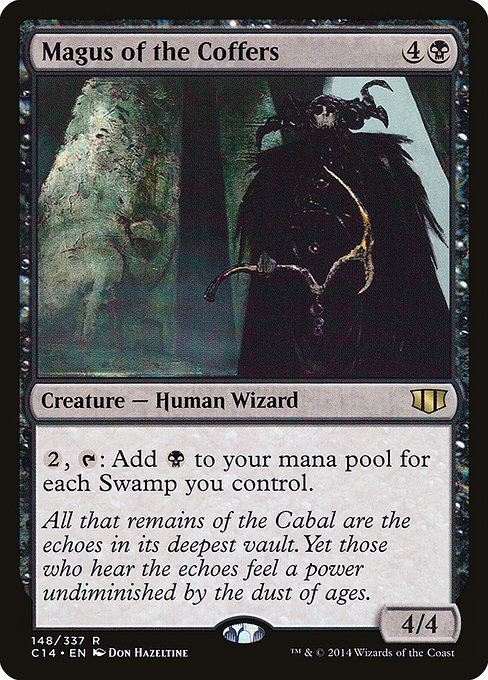
Magus of the Coffers never took off in the same way as Nirkana Revenant, but I’d argue it has also aged better. 5 mana is still a lot to ask for the privilege of playing a second copy of Cabal Coffers in your deck, especially when you have to wait a turn in order to use it, but the amount of mana you can get if it survives will fuel some very explosive spells and turns.
A 4/4 creature for 5 is a reasonable rate as well, though as with most of black’s best mana doublers, being a creature is a pretty significant drawback with the amount of spot removal and board wipes flying around. Still a great setup play, especially with an Urborg, Tomb of Yawgmoth somewhere on the battlefield, but not one I’d rely on in an emergency.
Bubbling Muck
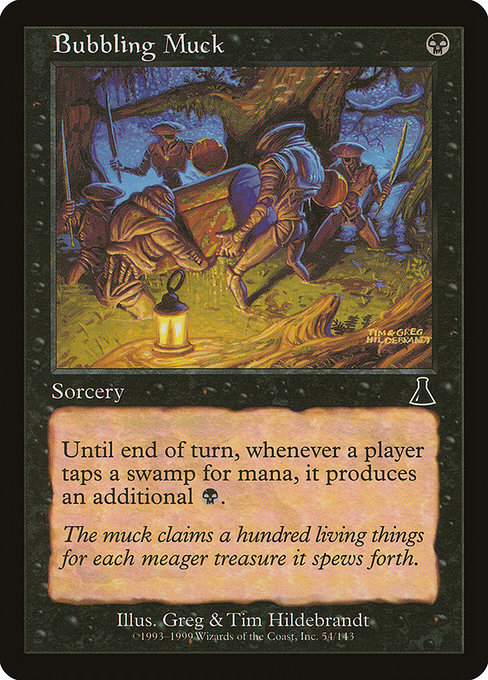
High Tide this isn’t, as being a sorcery limits you to shenanigans on your own turn. Don’t underestimate what Bubbling Muck is capable of though, as it can perform an excellent impression of High Tide in the right shell, and it can even pull off far more potent shenanigans when paired with blue’s ability to untap lands and recur sorceries.
This potency stems from Bubbling Muck‘s lack of need for a specific manabase when deckbuilding. Since Urborg, Tomb of Yawgmoth makes all lands into Swamps, so long as someone at the table has a copy in play, you can recur Bubbling Muck and untap lands as often as your cards will allow before casting a spell like Exsanguinate or Torment of Hailfire to win.
If comboing off isn’t your thing, Bubbling Muck is also good for quickly accelerating your mana once you have 4 or more lands in play. Just remember that it affects all players during the turn you cast it, so if you’re leaning on an Urborg, Tomb of Yawgmoth, your opponents may be able to play some expensive instants during your turn as well.
Crypt Ghast

Most perks I’ve listed about Nirkana Revenant, Magus of the Coffers, and Bubbling Muck apply to Crypt Ghast as well, so rather than extoll the virtues of Urborg, Tomb of Yawgmoth and X spells for the 4th time, I’ll instead start by saying 4 is a very reasonable mana cost for a one-sided mana doubler before moving on to the other half of Crypt Ghast‘s text box.
If you haven’t played with or against Extort cards (whose reminder text does not count when determining Crypt Ghast‘s color identity), Extort is a sneakily powerful ability. Early in the game, you can turn an extra mana into approximately 3 life while bleeding 1 away from all your opponents.
These are small enough numbers to normally avoid drawing the table’s ire, but large enough to give you a solid buffer against early attacks. My kind of card when it comes to table politics, as the mana doubling is almost always met with more concern than a few points of life.
Once you reach the final turns of the game, Crypt Ghast can also simply kill players with single digit life totals using these small bits of life loss. You’ll usually have ample mana to work with too, so what’s 1 more when casting a tutor, killing a creature, or putting one of your own out onto the battlefield?
Nothing, that’s what. And you’re picking up an extra bit of life to help keep yourself in the game while you’re at it. Talk about a win-win.
Is Black Mana Acceleration Worth It?
Your mileage is going to vary a lot here. If you’re looking for effects that add 1-time bursts of mana to your mana pool like Dark Ritual and Cabal Ritual, black and red are absolutely the colors to go to for them. If you are comfortable with incremental gains and slightly overcosted mana doubling, several of the cards in this list are absolutely worth looking at.
Whether you’re building for cEDH or more casual games, there is a clear truth for both types of decks – black’s playable mana acceleration spells are few and far between. No single color (other than maybe blue) forced me to search so diligently for playable cards, and virtually none hold any universal appeal.
Even white, which gets dumped on for being a bad mana ramp color (and rightfully so, though its situation is improving) had a strong suite of playables!
In the niches where these spells shine, however, they do so very brightly. In a worst case scenario, you test them out in a few games, replace them with other cards, and learn a little more about how your deck functions in the process. Best case? You find a card or two you never knew you needed until seeing it in action.
Other MTG Articles You Might Enjoy
- MTG Black Tutor Cards for Commander
- MTG Black Board Wipes for Commander
- MTG Blue Mana Ramp Spells for Commander
- Mono White Ramp Spells for Commander
- Token EDH Commanders
- Best Mana Rocks in EDH
Braden is a founder of Assorted Meeples and has been a gamer & writer with a vivid imagination all his life. Don’t believe us? Check out his excitement when meeting Goosebumps author R.L. Stine as a kid! An avid Magic: The Gathering spellslinger for over 15 years, you can always convince him to shuffle up for a game (or three!) of Commander.
